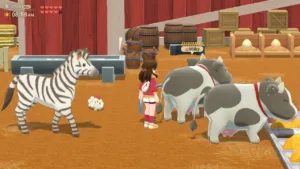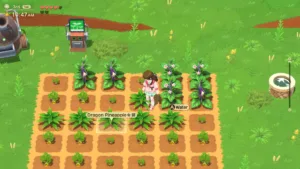When you think of cozy gaming, few names a few spring to mind but nothing hits nostalgia quite like Harvest Moon. For decades, the series has been the benchmark in gentle farming, heartfelt community life, and the satisfying grind of daily routines.
Harvest Moon: HSHSE promises to bring that same sense of comfort and belonging a homecoming of sorts both for its protagonist and for longtime fans. Beneath its charming surface, Home Sweet Home feels like a curious blend of heartfelt intention and outdated design. It’s a game that clearly loves its roots, but also struggles to evolve beyond them. It originally was a mobile game which eventually came to PC and now consoles and I think that is where this game falls short for people when it comes expecting a more fleshed out farming experience.
The story begins with a simple plot of you the player, return to your childhood village of Alba after years in the bustling city. The once vibrant community has lost its way with businesses closed, young people have moved away, and the town feels forgotten. Your mission is to rebuild it, one crop, friendship, and festival at a time. It’s a heartwarming setup that immediately feels familiar. The theme of rediscovering “home” resonates strongly and has been told many times in farming sim games. It is easy to get swept up in the peaceful pace of small-town life. You till your soil, chat with old friends to raise friendship levels, and slowly watch the village come back to life through your work and efforts.

While the concept is timeless, the execution leans heavily on nostalgia rather than innovation. The narrative unfolds in a linear fashion, with story progression tied to your progress in the town and your farm. You’ll meet a cast of friendly locals whom are shopkeepers, farmers, wanderers but many of them feel underdeveloped. Conversations are short, and relationship growth feels mechanical rather than emotional and don’t offer much variety. Still the tone is undeniable cosy and even with stiff dialogue the games message of rebuilding with acts of kindness and consistency you slowly get sucked into countless hours of farming and helping with requests.
At its core, Home Sweet Home sticks to the classic Harvest Moon formula. You wake up early, water your crops, feed your animals, and plan your day. Farming remains the main way to earn money and resources, and it’s easy to slip into the comfort of the daily grind. The farming system itself is decent but lacks depth. Crops grow in a straightforward cycle of plant, water, harvest with few surprises or dynamic weather effects. There’s little need for planning or experimentation, and the process can start to feel like a checklist rather than a way to be creative. Still, the simplicity might appeal to players seeking a low-stress experience, even though it’s hard to come to grips with the stamina bar and getting as much done under time and energy constraints early doors.

The Special Edition includes a few quality-of-life improvements. The new Hoverbike 5000 lets you zip across town faster than ever, and the Cleanmeister Autovac automatically takes care of some barn chores. These gadgets help reduce repetitive micromanagement, but they don’t fully eliminate the monotony that sets in over time and it takes some time to even achieve these upgrades because of the constant cycle of buy and sell.
Animal care is equally straightforward. You can raise cows, chickens, and sheep, each providing standard resources like milk, eggs, or wool. Animals have affection levels that improve with daily care, but these systems don’t meaningfully impact gameplay beyond small production bonuses which get tedious after hours of playing and receptiveness. It’s just a shame that beyond expanding your barn, there’s little sense of progression in animal raising.

Outside the farm, you can mine for ore, fish in local rivers and in the seas and gather items in the surrounding areas. These activities break up the day but much like farming, they follow very basic loops. The mines offer a sense of exploration early on, but quickly become predictable, with limited variety in rewards. Fishing is a simple timing-based minigame, pleasant but unremarkable. Foraging adds small bursts of discovery as you collect herbs, mushrooms, or flowers, yet these items often serve only as crafting materials or quick gifts rather than significant gameplay drivers.
One of the more interesting mechanics in Home Sweet Home is the ‘Happiness’ system. Every good deed from delivering items to villagers to holding festivals contributes to a collective happiness score. As the village’s happiness grows, new buildings open, new residents move in, and special events are unlocked. Whilst a clever idea the system lacks complexity and sometimes the ‘Happiness’ gauge is full and can take a few more days for the game to reward you for your efforts meaning any extra gains is just forfeit making the daily loop feel sluggish. Still, there’s a pleasant sense of purpose in knowing that every vegetable harvested and every fish caught has a direct impact on your town’s revival. It’s that kind of emotional feedback that keeps the game engaging even when the mechanics themselves feel shallow.

Visually Harvest Moon: Home Sweet Home Special Edition sits comfortably between charming and simplistic. The art style is bright and inviting, with lush green fields, pastel skies, and warm lighting that gives Alba Village a tranquil glow. Character designs lean toward the cartoonish, with expressive faces and vibrant outfits. The world feels static at times NPCs follow simple routines, and animations can appear stiff or robotic.
The music, however, nails the atmosphere. Soft acoustic tracks and cheerful melodies accompany your daily chores, changing slightly with the time of day and weather. The soundtrack may not be groundbreaking and offer lots of tracks but it fits the mood perfectly. The gentle background noise with ambient sounds like rustling leaves and distant animal calls, creating an immersive sense of calm and tranquillity

Since Home Sweet Home originally debuted on mobile, there was understandable scepticism about how well it would translate to console. Thankfully, the port to Xbox is handled fairly well. Menus are clean and easy to navigate, and the controller layout feels natural. Farming, fishing, and movement are mapped intuitively to the analog sticks and triggers. While there’s the occasional clunky moment such as struggling to align your character with tiles but it isn’t that much of an issue I found. The UI has been redesigned to suit larger screens for larger font and improved readability. Inventory management remains simple but could benefit from sorting options or quick-access shortcuts. It’s functional, though not particularly modern.
If there’s one thing Harvest Moon games have always done well, it’s creating a sense of peace. Home Sweet Home continues that tradition beautifully. The days pass slowly, filled with small goals and targets that reward you with a new crop harvested, a villager returning or being part of a festival. It’s less about adrenaline and more about mindfulness and self-care something we all must practice more often. If you’re the type of player who values atmosphere and comfort over plot twists and headaches, Home Sweet Home can feel like a calming grind you need at the end of a long day.
Overall
-
CX Score - 70%70%
Summary
Pros
- Relaxing and simple farming gameplay
- Cozy presentation
Cons
- Shallow farming systems
- Tedious loops
- Limited character depth and dialogue
- Price point for a mobile to console port

